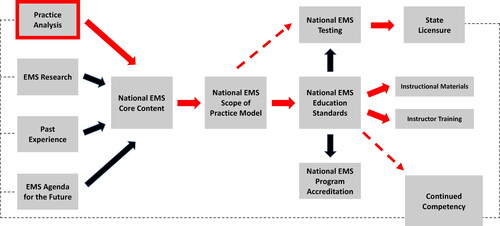Figures & data
Figure 1. The EMS practice analysis informs many aspects of the EMS educational systems in its roles as one of the key components of the system. From the EMS Education Agenda for the Future: A Systems Approach, 1999, https://www.ems.gov/pdf/education/EMS-Education-for-the-Future-A-Systems-Approach/EMS_Education_Agenda.pdf.

Table 1. Overall provider primary or secondary impressions by number of adult impressions
Table 2. Overall provider primary or secondary impressions by number of pediatric impressions
Table 3. Demographics of the study population (overall and by level of practice) for the phase 2 survey
Table 4. The potential harm to an adult and pediatric patient if proper care is not provided in the prehospital setting for EMS impressions rated with the highest possibility of harm (high harm >80% per respondents)
Table 5. Complete task/KSA matrix for the domain of cardiology & resuscitation, subdomain of focused assessment and pathophysiology

